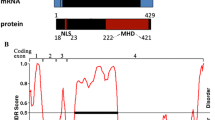Abstract
MAGE-1, which was originally identified by reacting with cytolytic T lymphocytes derived from the blood of melanoma patients, is a member of a gene family consisting of 17 structurally related genes. The MAGE genes are expressed only in the testis among normal tissues and in a number of human tumors of various histological types. Murine MAGE (also called SMAGE or Mage) genes were found in a study aimed at detecting mouse genes homologous to human MAGE genes. However, the biological functions of MAGE and Mage are currently unknown. To understand the biological functions of Mage, in the present study a recombinant SMAGE2 (Mage-b2) protein of 43 kDa was produced and monoclonal antibodies reactive with Mage-b2 protein were generated. One monoclonal antibody, smpG4A, specifically recognized a 43 kDa protein in lysates of Mage-b2 mRNA-positive sarcoma cells and of the testis. Immunohistochemistry showed that Mage-b2 is located in the nucleus of Mage-b2 mRNA-positive sarcoma cells. These results should contribute to understanding the biological functions of Mage.
Similar content being viewed by others
Author information
Authors and Affiliations
Corresponding author
About this article
Cite this article
Lee, JH., Sung, BW., Youn, HJ. et al. Identification, Expression, and Nuclear Location of Murine Mage-b2 Protein, a Tumor-associated Antigen. Mol Cells 10, 647–653 (2000). https://doi.org/10.1007/s10059-000-0647-7
Received:
Issue Date:
DOI: https://doi.org/10.1007/s10059-000-0647-7




